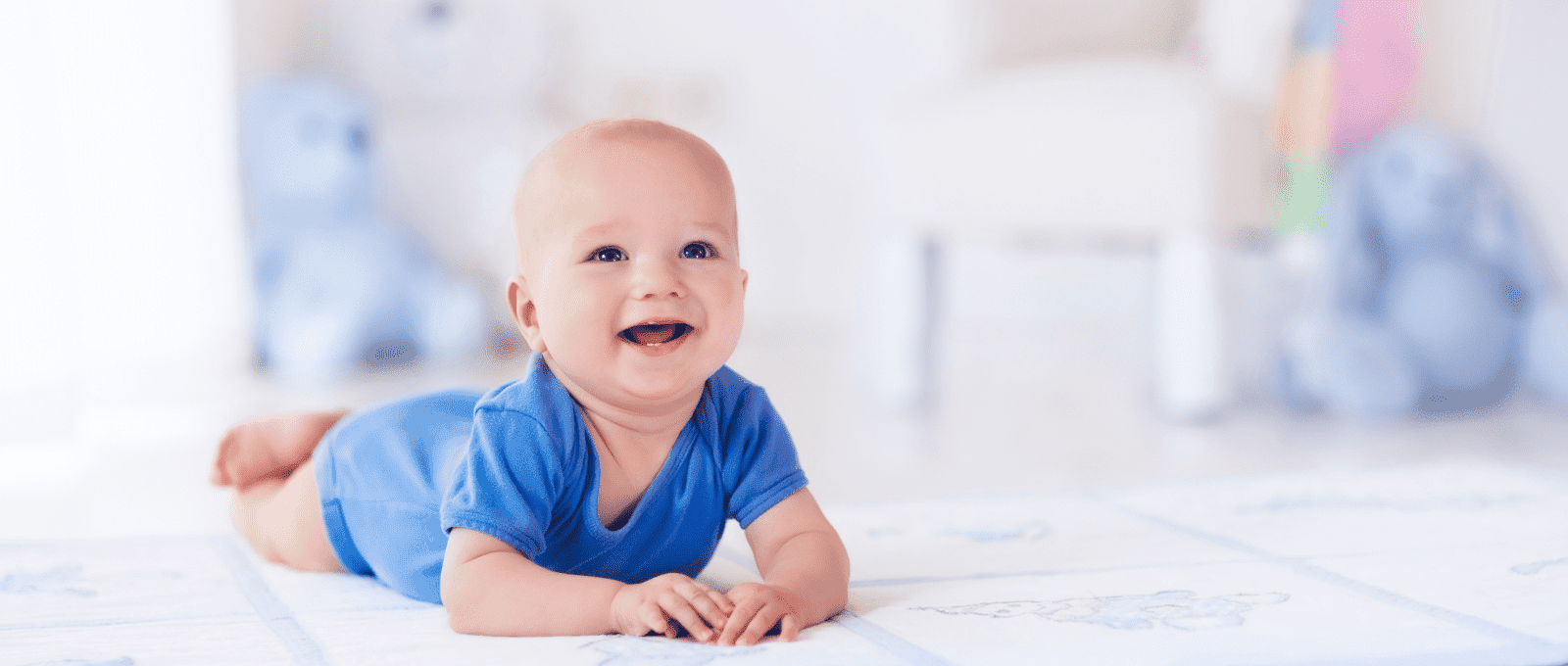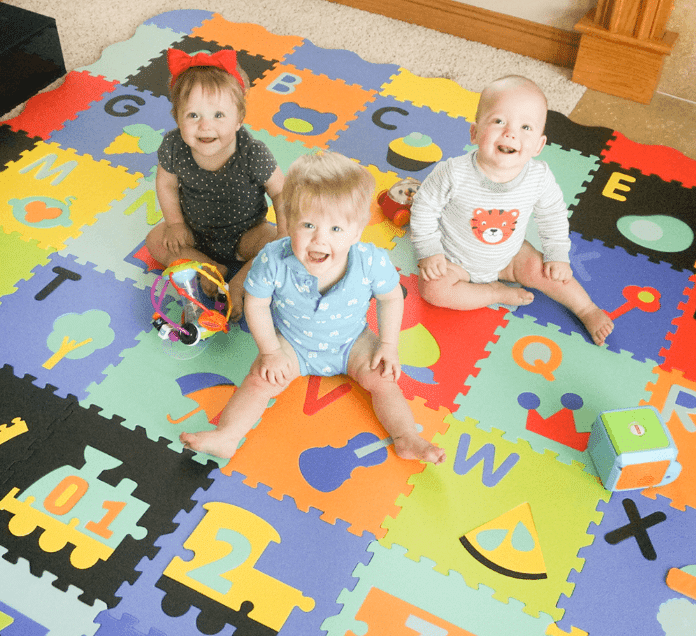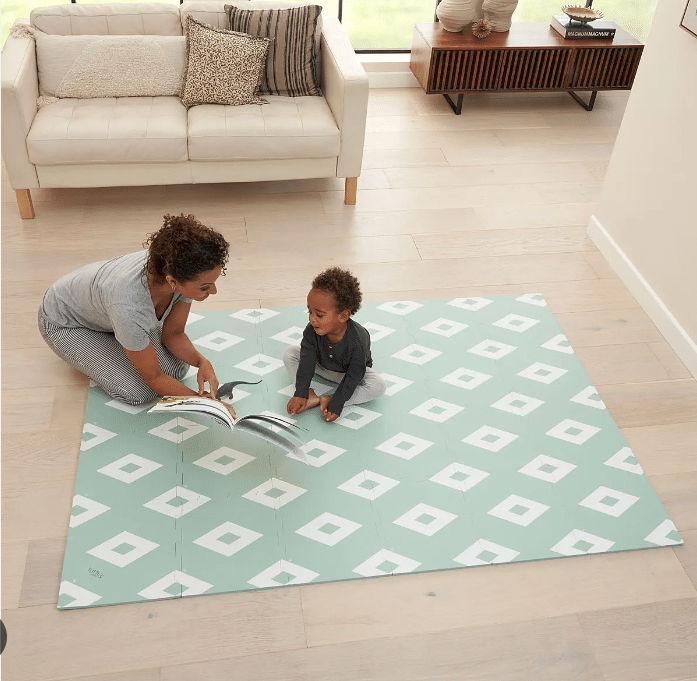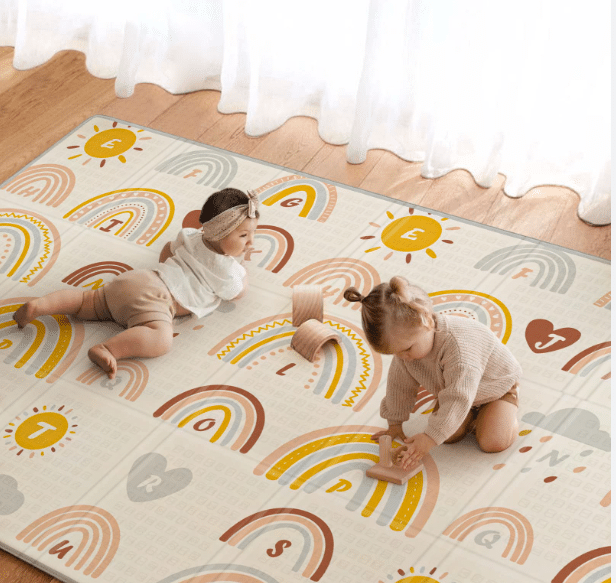
Exploring the Best Baby Playmats: Comfort Meets Early Learning
Introduction
As babies grow from helpless newborns to active toddlers, the nursery evolves to meet their changing needs. While cribs and dressers provide necessities for sleep and storage, open floor space gives little ones room to explore their expanding abilities. Blank floors, however, pose safety and comfort issues for babies just learning to lift their heads, roll over and crawl.
That’s where padded playmats come in. These soft, cushioned spaces allow babies to play, learn and develop key milestones in safety and comfort. Playmats take on many forms – from basic padded mats to deluxe activity gyms loaded with toys, lights and sounds. Their common thread is providing an ideal environment for growth in those critical early months.
This article delves into the many benefits of baby playmats. We’ll explore how they aid physical, sensory, cognitive and social development. After identifying key features that make playmats ideal for early learning, we’ll review top-rated options to suit a variety of nursery needs and budgets. From basic mats to stimulate the senses to loaded activity gyms to engage curious minds, playmats that combine comfort with interactivity nurture babies in those precious first years.

The Role of Baby Playmats in Development
As babies navigate major physical milestones in the first year, padded playmats provide an ideal surface for mastering movements safely. Tummy time – critical for building neck and shoulder strength – is more comfortable and engaging on a soft, vibrantly colored mat versus a hard floor. And when learning to roll, sit up and crawl, falls onto a cushioned mat allow babies to explore movement without injury.
Beyond physical development, interactive playmats stimulate cognitive growth in babies and young toddlers. High contrast patterns captivate eyesight still in its sharpest developmental stages. Manipulating dangling toys – grabbing, batting, twisting – builds hand-eye coordination and dexterity. Mirrors introduce self-awareness. Lights, music and variety keep curious minds engaged.
With abundant sights, textures and activities, playmats provide a rich sensory environment. Visual stimulation comes from bright colors, captivating patterns and engaging toys. Different materials offer diverse tactile input – plush fabrics, soft foam, crackly crinkles. Auditory elements like gentle music or squeaky toys heighten the experience. As babies grasp, kick and explore this sensory smorgasbord, neural connections multiply rapidly in their developing brains.
As they grow into toddlers, playmats become social hubs for play dates and family time. Special bonding occurs when parents get down on the mat to interact with babies during tummy time and other activities. Texture tags, peek-a-boo flaps and interactive toys provide endless games for sibling play. Versatile playmats work in nurseries, living rooms or play rooms to create gathering spaces for play and connection.

Review of Top-Rated Baby Playmats
With different designs catering to various priorities like safety, portability, education and style, selecting the ideal playmat depends greatly on each family’s needs and budget. Below we review top options meeting key criteria of comfort, developmental appropriateness and high quality materials.
Basic Baby Play Mat: Hape Foam Puzzle Alphabet Play Mat
Measuring 70″ x 46″, the Hape Foam Puzzle Alphabet Play Mat provides ample padded play space for babies and toddlers. The 1⁄2” thick foam offers cushioning over hard floors without being overly plush. This lightweight mat folds easily for storage and travel.
The bright colors and alphabet theme visually engage young children and encourage early learning. The included activity guide offers interactive games tailored to developmental stages from 4 months to age 4. This versatile mat transitions from tummy time surface to educational play space as babies grow.
The foam mat meets European and American safety standards. Its BPA- and phthalate-free construction makes it safe for babies to explore with their mouths. The wipeable surface allows for easy cleaning.
Best Infant Playmat: Infantino Grow-with-Me Activity Gym & Play Mat
The Infantino Grow-with-Me play gym combines an adjustable arch with a generous-sized padded mat designed for babies from infancy into the toddler years. The arch adjusts to place dangling toys within reach and to challenge advancing motor skills. A kick piano and language cards promote sensory, cognitive and fine motor development.
The machine-washable playmat measures 38” x 58” with 11⁄2” of padding – providing ample play space even for an active toddler. Its soft foam cushioning protects babies during tummy time and early mobility practice. A travel bag makes this versatile play gym/mat easy to transport for on-the-go use.
Best Interactive Playmat: Fisher-Price Kick ‘n Play Deluxe Gym
With a piano mat, dangling toys, lights, sounds and link loops for attaching additional toys, the Fisher-Price Kick ‘n Play Deluxe Gym overload curious babies’ senses and developing minds. The removable arch adjusts to place toys within reach. Kick sensors activate piano sounds, phrases, songs and flashing lights.
The generous 37” x 37” padded playmat provides substantial play space with soft cushioning for safety and comfort. Its machine-washable fabric withstands inevitable messes. This loaded activity gym stimulates babies’ visual, auditory, tactile and cognitive development.
Best Developmental Playmat: Lovevery Play Gym & Activity Mat
Designed by child development experts, Lovevery’s Play Gym focuses on age-appropriate stimulation. The arch adjusts for easy interaction with toys. 100% organic cotton, a wooden batting ring, crinkly ball and teether cater to senses and abilities from birth through toddlerhood.
The sizable 40” x 40” playmat features varying textures, hidden elements and developmental cards to engage babies as they achieve cognitive milestones. Its lightweight, portable design and machine-washable construction add convenience. As an award-winning baby gear brand, Lovevery emphasizes safety.
Best Stylish Playmat: Lorena Canals Washable Rug
For families wanting nursery decor to grow with a child, Lorena Canals playmats/rugs combine stylish patterns like bold stripes and whimsical motifs with plush padding for cushioned play. These handmade, fair trade rugs measure 55” x 79” – providing substantial play space well into the toddler years.
The 100% cotton absorbs spills easily while the slip-resistant rubber backing prevents slides on smooth floors. As a versatile accent piece, these durable rugs transition from nurseries to playrooms to living spaces – bringing vibrant style wherever imaginative play unfolds.

How to Choose the Right Baby Playmat
With myriad types and features available when shopping for a baby playmat, narrow your selection by prioritizing safety, versatility, developmental appropriateness and convenience.
Safety should drive every purchasing decision for baby products, especially floor surfaces where inevitable tumbles occur. Ensure adequate padding cushions falls and the mat itself presents no hazards. Select non-toxic, BPA/phthalate-free materials babies can explore safely with their mouths. Many quality playmats clearly mark safety certifications. Prioritize international standards like OEKO-TEX certification which indicates testing for harmful substances.
Look for versatility allowing a mat to adapt as your child grows from the tummy time stage into toddlerhood. Mats accommodating accessories like arches, toys, pillows and more keep pace with developing abilities. Foldable designs easily store away between children. Machine washability maintains hygiene through inevitable messes.
Developmental features also extend usefulness and value over time. Newborns need simple, high contrast patterns optimizing eyesight development. Add play gyms or dangling toys around 3 months when babies actively reach and bat. Mirrors introduce self-awareness around 6 months. Look for cause/effect toys, peek-a-boo elements and fine motor activities as babies mature into interactive toddlers.
For convenience, compact folding mats easily transport to grandma’s or the park. Lightweight designs move between rooms or stow away slimly. A carrying case adds portability. Washable materials simplify maintenance.
Beyond these key considerations, factor your lifestyle, priorities and budget. Do you envision using a mat for tummy time only or more actively once mobile? What safety certifications give you peace of mind? Do you prefer neutral color palettes or bright, stimulating hues? Does machine washability affect your decision? Do dimensions accommodate an active toddler? Getting clear on needs and preferences helps select the ideal playmat for your family.

Safety Precautions and Maintenance
While playmats provide safe spaces for babies to explore movement, you must take precautions to prevent injuries. Supervise play always – never leave a baby unattended on a mat or with toys due to strangulation or choking risks. Ensure the area is free of hazards like loose strings, plastic bags or small detached pieces. Stop use immediately if any damage creates sharp edges or small parts.
Follow all manufacturer guidelines for maximum weight, height and age recommendations. Generally, discontinued use around age 2-3 is advised as active toddlers can damage foam integrity. However, consult the manual for your specific mat’s limits based on materials and construction.
For maintenance, wipe non-fabric mats clean with mild soap and water, allowing to fully air dry before reuse. Machine wash fabric mats and accessories on gentle cycles in cold water, then air dry to prevent heat damage. Follow guidelines for using bleach or sanitizers if desired.
Check for rips, tears or holes regularly and discard immediately if found. Replace mats showing signs of wear, sagging, damage or fraying. Never attempt home repairs with tape, glue or stitching as these present safety hazards to curious explorers. Invest in a quality playmat that withstands reasonable use over time.
By selecting age-appropriate products from reputable brands, supervising play actively and performing routine maintenance, parents can optimize the safety and longevity of baby playmats. Prioritizing precautions preserves the integrity of these developmental tools.

Conclusion
A thoughtfully designed playmat provides an environment tailored to each stage of development in a baby’s first magical year. As infants gain strength to lift their heads, playmats make tummy time comfortable. Padded surfaces protect unstable bodies learning to roll, sit and crawl. Interactive toys captivate the senses and foster cognitive growth through sight, sound and texture.
These simple floor coverings transform open spaces into nurturing worlds where babies master essential milestones. As safe zones for play, they allow infants to explore movement independently while parents find moments of freedom to fold laundry or sip coffee nearby. For toddlers, playmats become social hubs for learning and connecting.
When selecting a playmat to support your child’s blossoming abilities, factor safety, versatility, developmental features and lifestyle fit. From basic padded mats to deluxe activity gyms, prioritizing comfort and interactivity cultivates growth in those precious early years.
As babies navigate immense physical, emotional and intellectual development, devote floor space – and budget – toward an engaging playmat. This simple addition transforms any room into a stage primed for childhood magic. Watch in wonder as your baby discovers the world from the ground up, strengthened and emboldened by a nurturing foundation that combines multi-sensory play with plush padding. Let the show begin!
Here are the FAQs to include in the article:
FAQs
What are the key features to look for in the best baby playmats?
The key features to prioritize are safety certifications, cushioned padding, engaging colors/patterns to stimulate vision, textures that stimulate touch, dangling/interactive toys to build coordination, and machine-washable fabric for easy cleaning. Also consider portability and developmental appropriateness from infancy through toddlerhood.
How do baby playmats aid in an infant’s sensory development?
Baby playmats aid sensory development through sights, sounds, and textures that stimulate an infant’s vision, hearing, and touch. Vibrant colors and contrast patterns optimize visual development. Different materials like plush and crinkly introduce new tactile input. Sounds from toys or musical elements support auditory growth. These multisensory elements strengthen neural connections in a baby’s developing brain.
Are foam playmats safe for newborns?
Yes, foam playmats made from non-toxic EVA foam are safe options providing a cushioned surface for newborns. Ensure any foam meets safety standards like OEKO-TEX certification. Avoid soft plush padding that could pose suffocation hazards. Supervise newborns closely and always place them on their backs according to SIDS prevention recommendations.
How often should baby playmats be cleaned, and what’s the best method?
Clean baby playmats at least weekly or whenever soiled by wiping with mild soap and water. For machine-washable mats, launder on the gentle cycle using cold water and mild detergent whenever dirty, about every 1-2 weeks with regular use. Always allow mats to fully air dry before reuse.
Can baby playmats be used for activities other than tummy time?
Yes, baby playmats have many uses beyond tummy time including rolling, sitting, crawling and playing with interactive toys while lying on backs or sides. As babies become mobile, playmats provide padded surfaces for more active floor play like building blocks, reading books and doing puzzles.
At what age should a baby start using a playmat, and until when can they use it?
Babies can start supervised tummy time on playmats as early as day one. Playmats remain useful into the toddler years depending on the size and developmental appropriateness of toys. Many play gyms accommodate children up to 3 years old. Pay close attention to each product’s age recommendations.
